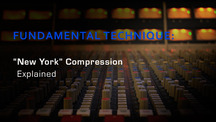Using compression effectively is fairly easy once you get your head around the principles of what it does to your signals, and it’s the simplest way to give your sounds some of that elusive pro punch.
Moreover, getting punchy drums is really key in any genre these days, be it rock, techno, dubstep or drum & bass. Even in modern movie soundtracks, you really want those huge orchestral percussion hits pummeling the audience with the force of an explosion!
Parallel compression is one technique that can help here. It sounds complicated but it’s not – you simply duplicate your drum track (or any other type of track), and then heavily compress the duplicate, leaving the original uncompressed.
When you play them back together, you get the powerful ‘breathing’ dynamic sound of the compressed version, whilst still retaining the detail, brightness and clarity of the uncompressed version. The best of both worlds… Incidentally, another term for parallel compression is “Motown compression”, because part of the famous old 60’s Motown sound was created by using parallel compression with an EQ inserted right before the compressor, tweaked specifically to highlight the vocals. So whether you’re inspired by Marvin Gaye’s Motown classics, or other compression fans like Dutch drum & bass heroes Noisia (you should really be listening to both in my opinion), give parallel compression a try.













